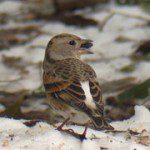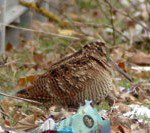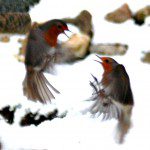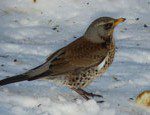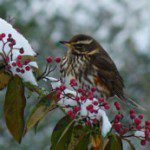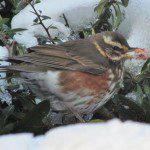NB: The following is reproduced by kind permission of Axe Estuary Birds. Full credit goes to the team that produces the newsletter (see the bottom of the post for specific details). Photographs are credited throughout the text although we are working to preserve the original layout wherever possible in the future.
Axe Estuary Birds No 147 31st December 2010
A Happy New Year to you all – and good Birding in 2011
First, a big “thank you” to Steve Waite, who has been co-editor of this newsletter for over three years, and his contribution has been terrific. He actually saved the newsletter from extinction, as I was unwell at the time and would have given up had he not stepped in to fill the breach. I am sure we all wish him well in this momentous year for him (apart from now being the DBWPS Bird Recorder for all Devon, he is getting married!) and for a happy and prosperous future.
The Birds
The region’s heaviest snow for many years hit many birds hard, with large numbers of thrushes and other species being forced to look for food in towns and gardens throughout the patch. With most water bodies frozen over too, wildfowl and some wading birds also struggled and had to look elsewhere for food.
Thousands of Redwings, Fieldfare, Song Thrushes, Blackbirds and fewer Mistle Thrushes could be seen feeding in gardens in the lead up to, and during Christmas Day. But as well as the grounded birds, massive flocks could be seen flying west over the patch looking for snow and ice-free ground. Meadow Pipits were also noticeable, trying to find food on roads, verges and gardens. Skylarks were constantly flying overhead, many tens of thousands passed through – the only count being of 11,250 over Colyford within a few hours on the morning of 18th. A Lapland Bunting was also seen briefly during this watch.
A couple of Black Redstarts, a higher than usual number of Blackcaps, and Bramblings (including up to eight in one garden) were also noted in gardens in this period. Weirdest sighting though goes to a pair of Teal, watched feeding amongst Pheasants, Blackbirds, and Chaffinches on bird food in a small front garden, surrounded by woodland, on the western edge of Seaton on Christmas Day morning. Bizarre!!!
All the local birders were hoping to bump into a Waxwing or more during this period, a lot of searching was undertaken. One was watched in Axminster on 27th, and three were reported by a non-birder feeding amongst Redwings and Fieldfares in a Seaton garden on 21st. But that was it. None were seen for long or by many – but there’s still time as there are still big numbers about pushing towards the south west of England.
Waders on the Estuary have included a handful of Golden Plovers, the occasional Ruff, a Grey Plover throughout, up to 70 Dunlin still and a Jack Snipe on 24th. Common Snipe and Woodcock were seen in unusual places during the cold snap, with some of the former in gardens, and two of the latter on Seaton Play Park on Boxing Day.
Wildfowl have been well represented, though more Geese were expected considering the weather conditions, singles of Greylag and Brent were all we had. Goosanders continued to feature regularly with between one and three female-types being noted on the Estuary on most days. A count of Wigeon on 28th revealed 1,800 birds, with locally scarce ducks including about 10 Gadwall throughout, five Tufted Duck on the Axe between Musbury and Colyford on 24th and four Tufted Duck and three Pochard on the Estuary on 28th.
One lucky local had a Hooded Crow briefly on their Colyford bird table on 24th. This is a major rarity so far south, but with hybrids proven (known as half Hoodies!), there will always be question marks over the purity of birds seen this far from home.
As David has mentioned in the previous couple of newsletters, this is my last newsletter. I have thoroughly enjoyed writing this twice monthly summary of birds seen around the Axe, and I hope you have enjoyed reading it. I would continue it, but other voluntary commitments that I have recently taken on must take priority. I will end by wishing everyone a very Happy New Year, and briefly summarising the response I finally got from the Norwegian Ringing Office regarding the colour-ringed juvenile Osprey that graced our Estuary during September and October of this year…
“The Osprey that was seen on the Axe Estuary, Devon, was ringed as a chick in its nest on 26/07/10 at MOKKAVATNET, Steinkjer, Norway by the Nord-Trøndelag Ringing Group. There was a gap of 52 days and a distance of 1715 km between the ringing date, and the date it appeared in Devon”
Photos: Redwing and Fieldfare – Steve Waite; Brambling and Woodcock – Karen Woolley.
News from Holyford Woods
The day the snow came, the Woods were totally transformed, becoming a magical silent place. For all the time the snow stayed, there was no wind, and even the globs of snow resting on the smallest branches and twigs stayed put. I have been able to enjoy five beautiful walks in a winter wonderland. To begin with walking was hard work especially along The Hangings, for Paco as well. There were many animal footprints but because of the depth of the snow it was almost impossible to distinguish them. Paco inspected the setts and earths with little interest. Bird activity was much reduced, though the Greater Spotted Woodpecker was happily hammering away, and the snow had done nothing to dampen the ardour of the two Ravens! One morning when the corvids were returning from the pig fields, they met a Peregrine Falcon flying South and chased it on its way. I wonder what the coming year will bring. Jean Kreiseler
The Trivia
Robins are the definitive symbol of Christmas Spirit, but these two don’t appear to have much of it! Photo Simon Wakely
Dave Mann writes “As you probably know we have a large amount of Redwings and Fieldfares around at the moment. In Colyton I was watching them feed on a tree which was covered in berries when a “Skylark” came onto the tree and began to feed. This was such a strange sighting as I have only ever seen them ground feeding or feeding on insects in the air. Have you heard of a Skylark feeding from a trees before? Identification was OK as I was only some 6 feet away from the tree, and as I moved it “crested” and flew off. Bizarre behaviour. Have looked in various books but no mention of tree feeding even at this time of year. Perhaps you or others may help in this respect.” Anybody else seen this?
Roy Aley reports Brambling in his Colyton garden – his report was the first of several this winter.
There have been sightings of House Martins all winter, but this is the latest. Lynda Weare say “At about 12.30 on Wednesday 29th we saw a single House Martin flying in Shapwick Valley, (East of Trinity Hill Road).” And asks “Have there been any other sightings?”
Mike Lock reports:- “The freeze has driven many more birds onto the river. On the afternoon of the 24th, at Nunford Hole (between Musbury and Colyton) there were five Tufted Duck (one male, four females), a Coot, about a dozen Teal, and 3-400 Wigeon, the latter either resting on the river or feeding in the fields – their tracks in the snow led from one exposed tuft of grass to the next. There are also Little Grebes, probably about one every few hundred yards, but they are very shy and elusive. Also scattered pairs of Mallard. Last week a pair of Shoveler, too.
There are a lot of Mute Swans on the river, presumably because the grass they normally eat is covered, so that they are resorting to water weeds instead. There is a lot of competition for the best areas so lots of singles birds and small groups flying up and down the river, and lots of aggressive display.
On Sunday 26th the river in the Whitford area was frozen except where it runs really fast. Small groups of Wigeon still feeding on exposed grass tufts in the fields. Bewicks Swan with Mutes just downstream of Nunford Hole. A pair of Gadwall on the river a bit below Whitford Bridge. A single drake Pochard on the river below Woodhayne (upstream of Whitford). A few Teal scattered along the river but fewer than of late. One Snipe flying round at Nunford but very few in evidence – I suppose they have all moved down to the Estuary.”
I think this photo by Sue Smith is fitting as the last one of the year. For me it sums up the spirit of the season and looks forward to the spring.
This twice-monthly email newsletter is freely available to anyone who would like it, as is a periodic one about the activities of the East Devon Local Group of the Devon Wildlife Trust. Just send me an email with Axe Estuary Birds and/or East Devon DWT in the subject line. Also, for those without a computer, I will send a copy by post if you would like to send me some stamps.
Thanks to those who keep me informed –particular thanks to those of you who have promised me more after Steve “Retires” – please continue to tell me of any unusual, interesting or amusing sightings, and what is about locally, and send any photos you would like to share.
Steve, Jean and David. davidwalters@eclipse.co.uk. tel. 01297 552616 Mobile 0779 1541 744.

